อินเวอร์เตอร์ PCS มักมีลักษณะเป็นตัวแปลงแบบสองทิศทาง และเครื่องออล-อิน-วันสำหรับจัดเก็บออปติคัลขนาด 50-100kW ยังใช้ในระบบจัดเก็บพลังงานอุตสาหกรรมและเชิงพาณิชย์ขนาดเล็กและขนาดกลาง EMS ของระบบกักเก็บพลังงานทางอุตสาหกรรมและพาณิชยกรรมยังแตกต่างจากระบบกักเก็บพลังงานขนาดใหญ่ของโรงไฟฟ้า ระบบกักเก็บพลังงานทางอุตสาหกรรมและเชิงพาณิชย์มักไม่พิจารณาถึงความจำเป็นของการจัดตารางเวลากริดพลังงาน แต่ส่วนใหญ่จะจ่ายพลังงานให้กับสถานีไฟฟ้าในท้องถิ่น พวกเขาจำเป็นต้องมีการจัดการพลังงานและการสลับอัตโนมัติภายในเครือข่ายท้องถิ่น
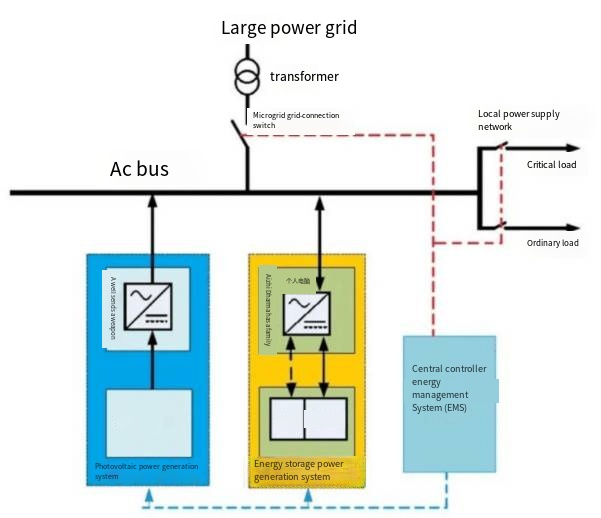
ระบบจัดเก็บพลังงานเชิงพาณิชย์และอุตสาหกรรมโดยใช้ PCS AC ควบคู่กับการจัดเก็บพลังงาน
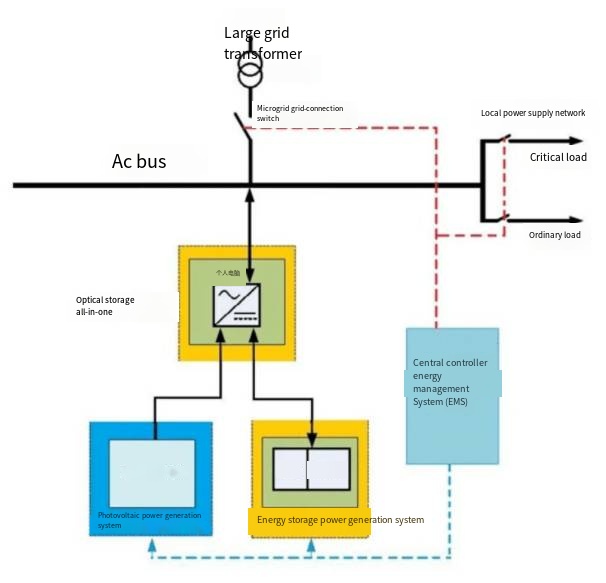
Industrial and commercial energy storage business model
The profit model of industrial and commercial energy storage is peak-valley arbitrage, that is, a low electricity price is used to charge in the trough of electricity consumption, and discharge in the peak of electricity consumption to industrial and commercial users, users can save electricity costs while avoiding the risk of power cut-off.
With the improvement of the TOU price, the difference between peak-valley prices widens, and the economy of industrial and commercial energy storage is significantly improved. At present, there are mainly two business models for the operation of industrial and commercial energy storage in China. First, industrial and commercial users install energy storage equipment by themselves, which can directly reduce the electricity cost, but the user needs to bear the initial investment cost and annual equipment maintenance cost. On the other hand, energy service enterprises assist users to install energy storage equipment. Energy service enterprises invest in building energy storage assets and are responsible for their operation and maintenance. Industrial and commercial users pay electricity costs to energy service enterprises.
At the same time, user-side energy storage has been expanded in multiple scenarios, such as charging and changing power stations, data centers, 5G base stations, ports and ports, and heavy trucks for power changing.
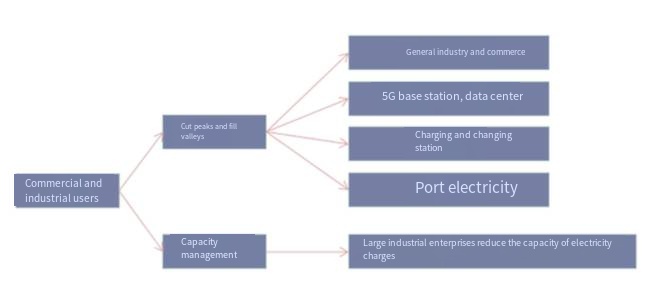
Specific analysis of profit channels of industrial and commercial energy storage industry
The commercial and commercial energy storage market includes photovoltaic commercial and non-photovoltaic commercial scenarios. For commercial and large industrial users, the PV + energy storage model can also be used for self-use. Because the peak time of electricity consumption is consistent with the peak time of photovoltaic power generation, the proportion of industrial and commercial distributed photovoltaic self-use is high, and the capacity of the energy storage system and photovoltaic power is mostly 1:1 configuration. For commercial buildings, hospitals, schools, and other scenarios that are not suitable for the installation of large-scale photovoltaic self-generating power, the purpose of peak cutting and
valley filling and capacity electricity price reduction can be achieved through the installation of the energy storage system.
1. New energy consumption
Photovoltaic has strong intermittency and volatility. When the power generation of photovoltaic power stations for self-use and surplus electricity is beyond the capacity of the load, the excess electricity will be sent to the grid at a lower price. When the photovoltaic load is insufficient, industrial and commercial users have to buy electricity from the grid, and the grid and photovoltaic system supply power to the load at the same time. Commercial and industrial users do not get the maximum reduction in electricity costs when they are equipped with PV. After the configuration of the energy storage system, the photovoltaic power is preferentially stored in the energy storage, and the residual power supplies the load. When the photovoltaic power is insufficient, the energy storage supplies power to the load. The energy storage system's smoothest power generation and power consumption improves the absorption rate of photovoltaic power generation and maximizes the benefit of electricity consumption to the greatest extent.
2. การเก็งกำไรจาก Peak-Valley
วิธีที่ตรงที่สุดในการเพิ่มมูลค่าให้กับระบบกักเก็บพลังงานคือการเก็งกำไรจากราคา Peak-Valley ผู้ใช้สามารถชาร์จแบตเตอรี่เก็บพลังงานได้ในราคาที่ถูกกว่าเมื่อโหลดต่ำ ที่โหลดสูงสุด แบตเตอรี่เก็บพลังงานจะจ่ายพลังงานให้กับโหลดเพื่อให้รับรู้การถ่ายโอนของโหลดสูงสุดและรับรายได้จากราคาของหุบเขาสูงสุด
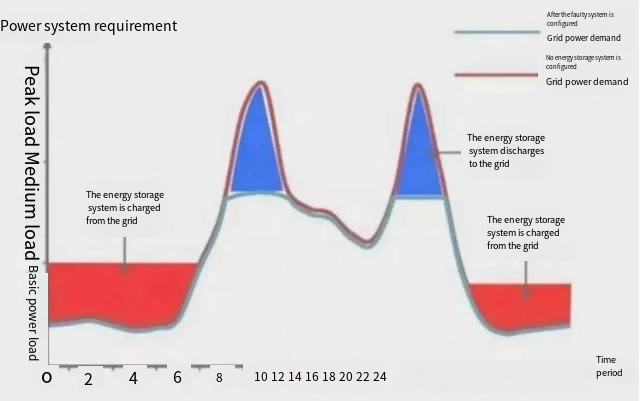
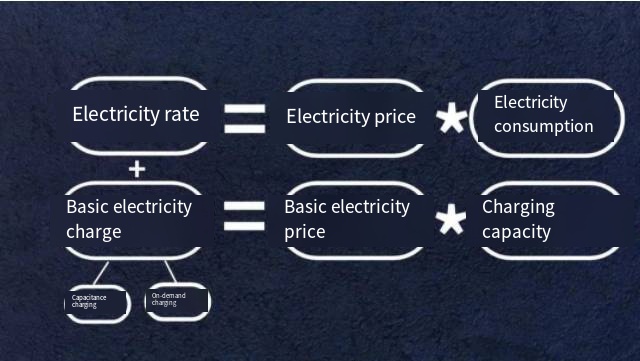
4. Power distribution to increase capacity
When the original power distribution capacity of industrial and commercial users is insufficient, the energy storage system can continue to charge quickly when the short-term power consumption is greater than the transformer capacity, to meet the requirements of load electric energy demand. Reduce transformer use cost, reduce transformer investment and expansion cycle.
5. Demand side response
Power demand response refers to that when the wholesale market price of electricity rises or the system reliability is threatened, power users change their inherent habitual consumption mode after receiving the direct compensation notice of induced load reduction or the signal of power price rise from the power supplier, to reduce or delay a load of a certain period and respond to the power supply, to ensure the stability of the power grid. And restrain the short-term behavior of electricity price rise.
Simply put, the enterprise in a power supply shortage, tatakeshe initiative to reduce electricity, through peak cutting and other ways, response to the power supply balance, and thus get economic compensation.
6. Spot trading of power
Power spot trading refers to the trading mechanism in which power generation enterprises and other market entities provide power services in the form of market trading. With the accelerated pace of China's electricity market reform, the country has introduced new policies to encourage energy storage to participate in the electricity spot market, and new business models for the energy storage industry have been activated.
7. Power auxiliary services
Paid power auxiliary services refer to the auxiliary services provided by the grid-connected generation side in addition to the basic auxiliary services, which can respond to the power dispatching instructions with adjustable loads (including aggregation through aggregators, virtual power plants, etc.).
Primary frequency modulation, automatic generation control, peak regulation, reserve, paid reactive power regulation, black start, and other paid auxiliary services should be compensated. Industrial and commercial energy storage can be a new profit channel through the provision of ancillary services in the electricity market.
เมื่อเร็ว ๆ นี้ โพสต์
สแกนไปที่ wechat:everexceed
